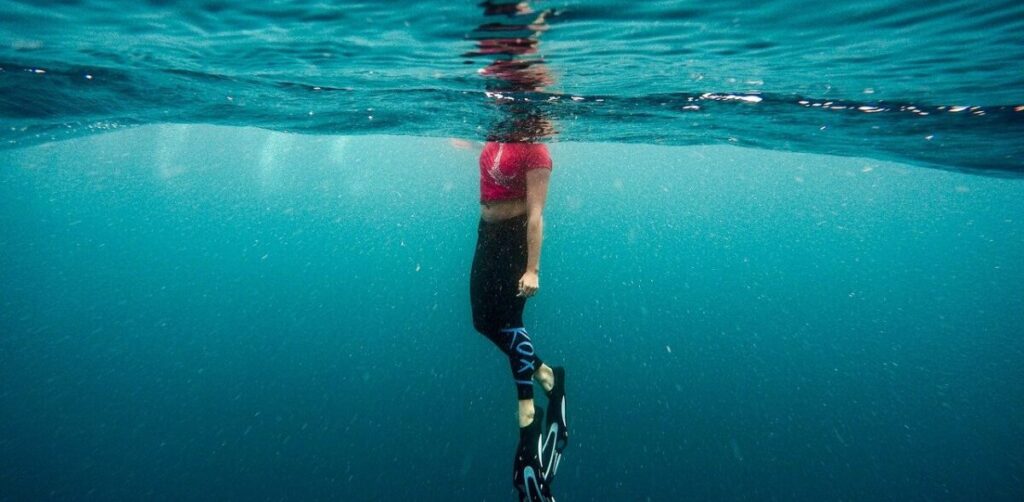

While you can scuba dive without a wetsuit, you miss out on many key protections. Scuba diving without a wetsuit should be limited to shallow dives and short periods of time.
Scuba diving without a wetsuit is a nice dream, but there are several key benefits you lose without a wetsuit. Keep reading to discover how deep scuba divers can go without a wetsuit and what they miss out on. We’ll also look at the possibility of diving in a swimsuit and what your options are there.
How Deep Can You Dive Without a Wetsuit?
The furthest depth you can dive without a wetsuit differs from person to person, as well as location.
The main concerns with not wearing a wetsuit center around protection from certain exposure. These include:
- Exposure to cold
- Exposure to the sun
- Exposure to the environment (i.e. wildlife, rocks, coral)
Some people only put on a wetsuit if they think they will get cold on a dive. If you’re staying close to the surface, this may not be an issue, but it gets exponentially colder the deeper you dive.
Even shallow dives may be affected by the sun and surrounding environment, so you should have good situational awareness and planning if you decide to dive without a wetsuit. In many cases, choosing a short wetsuit over one with full coverage is a better compromise.
Benefits of Wearing a Wetsuit
The benefits of wearing a wetsuit far outweigh the complaints. These include:
- Exposure protection
- Warmth
- Buoyancy control
- Better performance
- Greater peace of mind
Even a thin or low coverage wetsuit can check some of these boxes, keeping you safer in the water.
Exposure Protection
Wetsuits protect you from the environment in many ways, including reducing exposure to:
- The sun
- Marine life
- Rocks and coral
You might be surprised by how many people get sunburnt after spending all their time under the water. It’s easier to forget about sunscreen coverage, and the efficacy erodes as you spend more time in the water.
Beyond this, you can run into stinging jellyfish or sharp corals that easily nick your skin, causing burns and cuts that may need medical attention once you surface.
A wetsuit limits your exposure to different hazards in the environment.
Warmth
Wetsuits allow a thin layer of water to settle between you and then suit, and then the tiny air bubbles trapped in the suit use your body warmth to generate heat. While cold tolerance varies from person to person, most agree that a wetsuit works well for warmth even during shallow dives.
The water temperature is much cooler than the temperature at the surface, and wetsuits come in a variety of thicknesses to offer adequate warmth. You lose heat 25 percent faster in water than you do at the surface, so the insulation of a wetsuit helps quite a bit.
Assuming a neoprene wetsuit or drysuit, you can follow this charge for generally recommended suit thickness:
| Temperature Range at Surface | Recommended Suit Thickness |
| 76°F to 86°F (24°C to 30°C) | 1.6mm wetsuit (or a lycra dive skin) |
| 69°F to 84°F (21°C to 29°C) | 3mm wetsuit |
| 64°F to 77°F (18°C to 25°C) | 5mm wetsuit |
| 49°F to 75°F (9°C to 24°C) | 6.5mm wetsuit |
| 33°F to 66°F (1°C to 19°C) | 9.5mm drysuit |
While a drysuit is preferred in colder climates, you can see that wetsuits still offer phenomenal insulation when scuba diving.
Buoyancy Control
Diving with neoprene provides you with positive buoyancy. This helps you float while underwater.
While it can take a bit to get used to when coming from strictly swimming, this adds more peace of mind when diving to greater depths. You need to learn to control buoyancy when wearing a wetsuit, but you won’t feel like you’re aimlessly sinking.
Performance
Wetsuits help streamline your body, making it easier to get through the water. This may be a marginal benefit for seasoned swimmers, but it still helps you shave seconds to minutes off your dive times.
This performance boost translates to less exertion during your dive, and you’ll use less air in the long run.
Peace of Mind
Overall, these benefits offer you peace of mind. You aren’t stuck worrying about sunburn, stings, or hypothermia. You get less of the sinking feeling, and your body is less fatigued from regular diving duties.
This translates to less stress and more of your mind free to focus on diving responsibilities. You get to enjoy more from your dive without worrying about these variables.
Can You Scuba Dive in a Swimsuit?
You can scuba dive in a swimsuit, but most recommend it. This seems to work well for lower level activities, such as snorkeling, but scuba diving requires more movement and greater exposure to the elements. Diving in a swimsuit is not the best decision.
If wetsuits make you uncomfortable or you want greater mobility, short-style wetsuits may offer what you need. They still cover your torso, providing decent protection, without inhibiting the movement of your arms or legs.
Using wetsuits layers, such as jackets, can also allow you to customize your coverage as needed.
References
https://www.scuba.com/blog/scuba-gear/what-is-the-difference-between-a-wetsuit-and-a-drysuit/
https://www.wetsuitwearhouse.com/blog/the-benefits-of-wearing-a-wetsuit/
https://therookietri.com/wetsuit-or-no-wetsuit/
https://www.quora.com/Can-you-go-scuba-diving-wearing-just-your-bathing-suit
